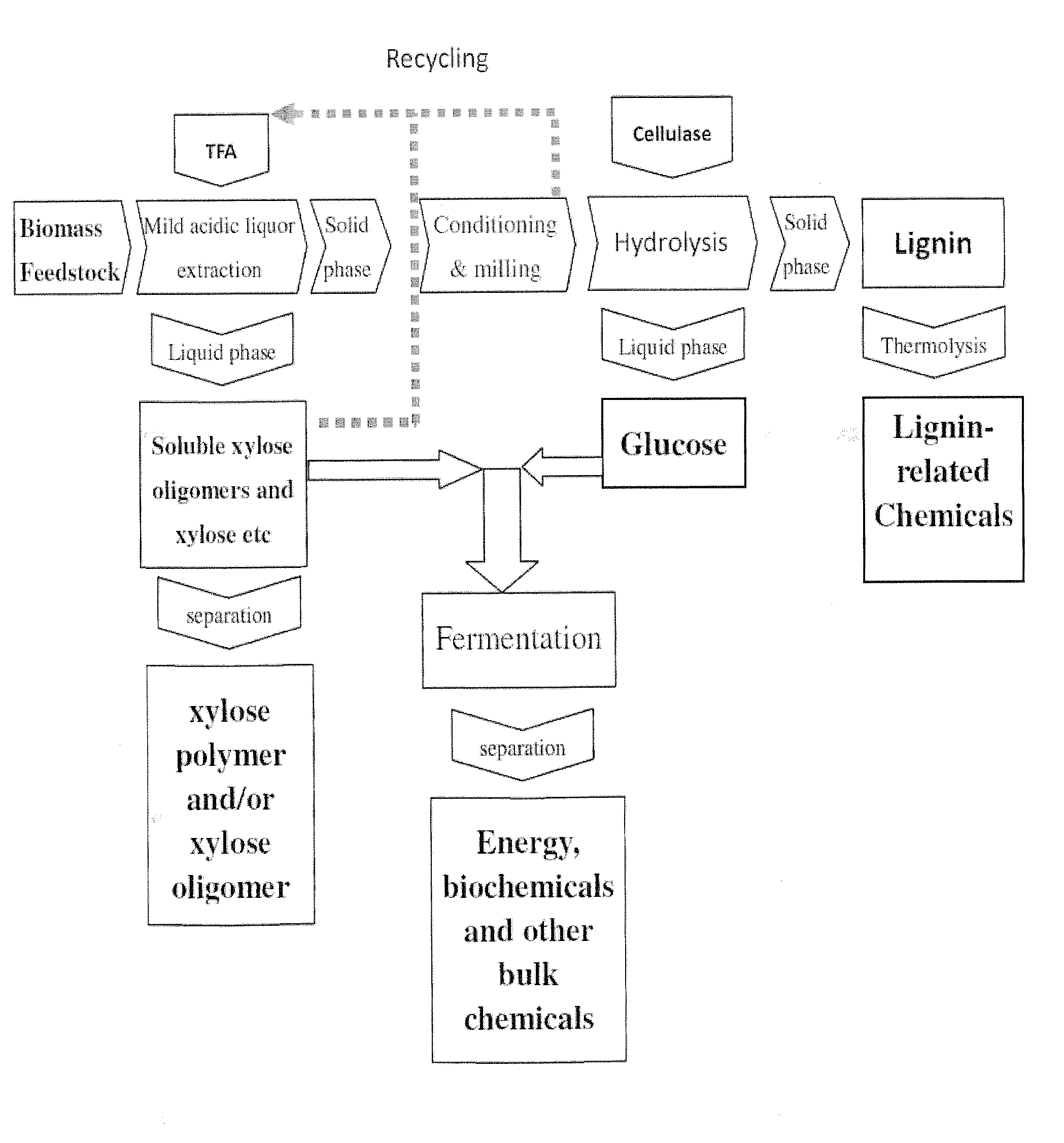Process for biomass conversion
a technology of biomass and process, applied in the field of biomass conversion, can solve the problems of polluting rivers and leaking waste water, and achieve the effect of easy grinding
- Summary
- Abstract
- Description
- Claims
- Application Information
AI Technical Summary
Benefits of technology
Problems solved by technology
Method used
Image
Examples
example 1
Experiments 1 to 8
[0150]Wheat straw is dried at 50° C. and cut into fragments 2.5 cm in length. 1.0 g straw fragments and 10 ml of trifluoroacetic acid (TFA) at a concentration of 30%-100% are added to a hydrothermal reaction vessel, sealed, and heated at 80° C. for 3 hours. The resulting reaction mixture is cooled to room temperature and then filtered. The resulting filtration solid residue is dried at 50° C. for carbohydrate and lignin analysis. The remaining TFA in the filtration is evaporated with a rotary evaporator before a reducing sugar analysis of the resulting filtration solid residue.
[0151]In Table 1, the initial concentration of trifluoroacetic acid (TFA), the reducing sugar yield in supernatant, the amount of solid residue mass, and the carbohydrates and lignin content of the residue are shown for Experiments 1 to 8.
TABLE 1Experiments 1 to 8Reducingsugar yieldTFAinSolid residueconc.supernatantSolidCarbohydratesAcid insolubleSolubleExperiments(%)(g)mass (g)(%)lignin (%)l...
example 2
Experiments 9 to 16
[0152]Wheat straw is dried at 50° C. and cut into 2.5 cm fragments. 1.0 g straw fragments and 10 ml of 75% trifluoroacetic acid (TFA) of different concentration are added to a hydrothermal reaction vessel, sealed, and heated at 80° C. for 2 to 24 hours. The resulting reaction mixture is cooled to room temperature and then filtered. The resulting filtration solid residue is dried at 50° C. for carbohydrate and lignin analysis. The remaining TFA in the filtration is evaporated with a rotary evaporator before a reducing sugar analysis of the resulting filtration solid residue.
[0153]In Table 2, the initial concentration of trifluoroacetic acid, the reducing sugar yield in supernatant, and the amount of solid residue mass, the carbohydrates and lignin content of the residue are shown for Experiments 9 to 16.
TABLE 2Experiments 9 to 16Reducingsugar yieldSolid residueinAcid-TimesupernatantSolidCarbohydratesinsolubleSolubleExperiments(hours)(g)mass (g)(%)lignin (%)lignin (...
example 3
Experiments 17 to 25
[0154]Wheat straw is dried at 50° C. and cut into 2.5 cm fragments. 1.0 g straw fragments and 10 ml of 75% trifluoroacetic acid (TFA) of different concentration are added to a hydrothermal reaction vessel, sealed, and heated at 70° C. to 150° C. for 3 hours. The resulting reaction mixture is cooled to room temperature and then filtered. The resulting filtration solid residue is dried at 50° C. for carbohydrate and lignin analysis. The remaining TFA in the filtration is evaporated with a rotary evaporator before a reducing sugar analysis of the resulting filtration solid residue.
[0155]In Table 3, the initial concentration of trifluoroacetic acid, the reducing sugar yield in supernatant, and the amount of solid residue mass, the carbohydrates and lignin content of the residue are shown for Experiments 17 to 25.
TABLE 3Experiments 17 to 25Reducing sugarSolid residueyield inSolidSolubleTemperaturesupernatantmassCarbohydrateAcid-insolubleligninExperiments(° C.)(g)(g)(%...
PUM
| Property | Measurement | Unit |
|---|---|---|
| temperature | aaaaa | aaaaa |
| temperature | aaaaa | aaaaa |
| weight | aaaaa | aaaaa |
Abstract
Description
Claims
Application Information
 Login to View More
Login to View More - R&D
- Intellectual Property
- Life Sciences
- Materials
- Tech Scout
- Unparalleled Data Quality
- Higher Quality Content
- 60% Fewer Hallucinations
Browse by: Latest US Patents, China's latest patents, Technical Efficacy Thesaurus, Application Domain, Technology Topic, Popular Technical Reports.
© 2025 PatSnap. All rights reserved.Legal|Privacy policy|Modern Slavery Act Transparency Statement|Sitemap|About US| Contact US: help@patsnap.com


